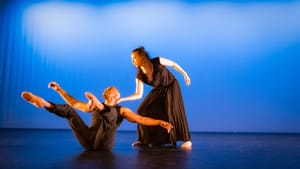Stay in the Loop
BSR publishes on a weekly schedule, with an email newsletter every Wednesday and Thursday morning. There’s no paywall, and subscribing is always free.
Dance goes meta
DanceVisions presents Meredith Rainey’s BUILDING

The DanceVisions residency program at the Performance Garage welcomed Meredith Rainey this season. His culminating work, BUILDING, brought the audience into his creative process, including the challenges and joys of making art, working with others, and managing expectations.
This program provides support to resident artists who develop and stage new choreography. Previously, Rainey’s work has been performed by Royal Winnipeg Ballet, Brandywine Ballet, Delaware Ballet, Incolballet in Colombia, and others. He danced with the Philadelphia (formerly Pennsylvania) Ballet, BalletX, Milwaukee Ballet, Dance Theatre of Harlem, and Complexions.
A refreshing approach
Rainey’s unusual approach to BUILDING made for refreshing work. Dance does not usually get meta, but Rainey wove elements of metatheater, which highlights the ways that a performance is a performance, throughout the work. Including himself in the show as a dancer, actor, and guide made this especially effective.
A non-traditional beginning made it hard to discern precisely when the show started. Ticket holders waited for the house doors to open, but instead, rolling panels slid away to reveal a small section of the stage visible from the lobby. Fractured snippets of the song “O-o Child” played as Rainey and another dancer moved slowly toward the audience. This repeated intermittently until the house doors opened and viewers took their seats. Then Rainey began to introduce BUILDING with the sort of remarks that often precede a performance: discussing the theme, recognizing grantors, and giving thanks.
This, too, was part of the performance. Rainey incorporated his opening address into the choreography as the dancers entered while he spoke, silenced him with a hand over his mouth, and then lifted and moved his body. Rainey resembled a marionette manipulated by Marco Emilio Bonnes Gavillan, Mikal Gilbert, Brandi Pinnix, and Andie Yorita.
Transcending dance
Meanwhile, Chandra Moss-Thorne stood off to the side watching. Her role in BUILDING transcended dancing. Like Rainey, the dancers also acted. But while he played a version of himself, the other characters embodied facets of Rainey’s thoughts and feelings. Rainey is a natural actor, and Yorita shone alongside him in a scene with dialogue. Yorita’s character portrayed neediness, along with fear that the creative process requires more than the creator can give. She stood uncomfortably close to Rainey, who flung away her touch. Both personas landed as human and relatable.
Moss-Thorne, however, played a guide who dispensed support and tough love as necessary. She shadowed Rainey, wearing a costume different from the other dancers. Moss-Thorne’s hand covering Rainey’s mouth, a recurring gesture, suggested stages of the creative process and states of being within it. Creators must confront and address—or silence—their doubts. Similarly, thinking and talking can be useful in developing new work, but racing thoughts and anxious rambling don’t help. At some point, a choreographer needs to stop talking and start dancing.
Several scenes appeared candid and unscripted. After an intense dance sequence, Moss-Thorne asked Rainey how he was doing and provided verbal support. Truly out of breath, Rainey lent rawness to an admission of worry and overwhelm. In scenes with dialogue, voices overlapped and interrupted in ways that mirrored natural conversation. At the same time, breaking the fourth wall called attention to the fact that BUILDING was a performance. These added reflexive layers and struck a pleasant contrast with the polished dancing.
More meta
The movement upheld the theme in scenes resembling rehearsals. Rainey seemed to create dance upon Gavillan and Gilbert, whose fluid spins and high kicks were a delight. Then Rainey directed his attention to a line of dancers, who retreated backward as if compelled by Rainey’s intensity. Pinnix captivated as she physically conveyed being blown away. She partnered well with Gilbert as well as Rainey, who lifted Pinnix as her legs formed a diamond shape.
Rainey closed out BUILDING by resuming his opening remarks as if the dancing had been a brief digression from them rather than the main event. Initially, I was not sure whether I liked it, but BUILDING won me over. Metatheater’s ability to emphasize the artificiality of performance has been traced to ancient Greece. Yet it feels particularly relevant in the 21st century as the boundaries between real and artificial continue to blur. And while metatheatrical devices proliferate in film and TV, they originated on stage. Dance rarely gets meta, but BUILDING left me wishing it would more often.
What, When, Where
BUILDING. Choreography by Meredith Rainey. DanceVisions; presented by the Performance Garage. $15. May 16-17, 2024, at the Performance Garage, 1515 Brandywine Street, Philadelphia. performancegarage.org.
Sign up for our newsletter
All of the week's new articles, all in one place. Sign up for the free weekly BSR newsletters, and don't miss a conversation.

 Melissa Strong
Melissa Strong